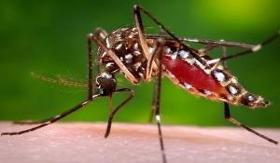It's a New Day in Public Health.
The Florida Department of Health works to protect, promote, and improve the health of all people in Florida through integrated state, county, and community efforts.
Chikungunya Fever (CHIK)
April 1, 2014 Interagency Webinar Presentations
Mosquito Control Measures CHIK
Epidemiology and Medical Importance CHIK
Chikungunya Virus: Preparing Florida for an Emerging Threat
Chikungunya Virus: Preparing Florida for an Emerging ThreatFor a recording of the April 1st training please contact
Epi.Training@flhealth.gov and list "CHIK Training" in subject line.

Chikungunya fever (CHIK) is an infection caused by the Chikungunya virus (CHIKV). The virus is spread through the bite of an infected mosquito, similar to West Nile and dengue viruses. The Chikungunya virus was first identified during an outbreak in 1952 in southern Tanzania, although it is suspected to have been present in Africa and Asia for much longer.
- Symptoms
- Transmission
- Chikungunya Geographic Distribution
- Resources
An infected person will typically become ill three to seven days after the mosquito bite, but symptoms can begin anywhere from two to 12 days post-bite. These symptoms can last 3-10 days. Up to 28% of people who are infected will not have any symptoms (asymptomatic), although they can still be infectious to mosquitoes for a short time if bitten. Persons at greatest risk for severe illness include newborn infants, those over 65 years of age, and those who have other health conditions. Treatment is symptomatic or supportive.
Symptoms may include:
- Sudden high fever (usually > 102ºF) which may be continuous or intermittent
- Severe joint pain that commonly involves the hands and feet
- Joint swelling
- Back pain
- Rash usually 2-5 days after fever starts
- Other symptoms may include headache, body ache, nausea, vomiting, and redness around the eyes. In unusual cases, infection can involve the brain, eyes, heart, kidney and other organs.
- Fatal infections are rare, however many patients have chronic joint pain, arthritis, loss of energy and depression lasting weeks to years.
Chikungunya virus is spread by two mosquito species: Aedes aegypti(primarily) and Aedes albopictus, both found in Florida. While the virus is not currently found in the state, introductions are possible if a CHIKV infected visitor or returning traveler is bitten by Florida mosquitoes in the early stages (the first week) of their illness. Infected mosquitoes can then spread the virus to other people they bite.
Chikungunya and Dengue
It is important to note that a person can be infected with CHIK and dengue viruses at the same time as they are both carried by the same types of mosquitoes. Therefore, it is important that providers consider both dengue fever and CHIK when evaluating suspect cases with travel to areas where both viruses are present. Testing is the only way for a health care provider to definitively differentiate CHIK and dengue fever.
Chikungunya fever outbreaks have been reported in Africa, southern Europe, Southeast Asia, India, and islands in the Indian and Pacific Oceans. In December 2013, a cluster of CHIK cases were reported from St. Martin, an island in the Caribbean. This is the first known occurrence of local CHIKV transmission in the Americas. Since that time, chikungunya has spread throughout the Caribbean and into Central and South America.
There have been several focal local introductions of chikungunya into Florida in 2014. However, none of those introductions appears to have resulted in ongoing transmission or spread of the virus. Significant local transmission has been reported in Puerto Rico and the U.S. Virgin Islands, but has not been reported in any other regions of the United States.
Please visit the CDC website for more infomation on the geographic distribution.
Chikungunya in the United States | Chikungunya Virus | CDC
Mosquito-borne disease prevention tips
Information from the CDC on CHIK
CDC Chikungunya Information Sheet
Information specific to Preparedness and Response for CHIKV Introduction in the Americas
To see a list of travel health notices issued by the Centers for Disease Control and Prevention please visit: http://wwwnc.cdc.gov/travel/notices
*Note: This page contains materials in the Portable Document Format (PDF). The free Acrobat Reader may be required to view these files.



Connect with DOH